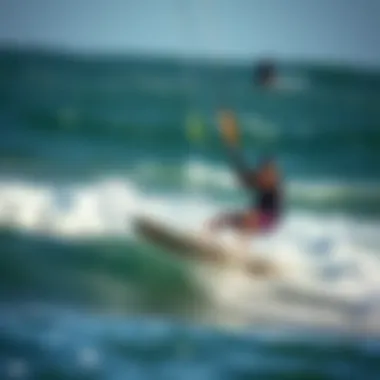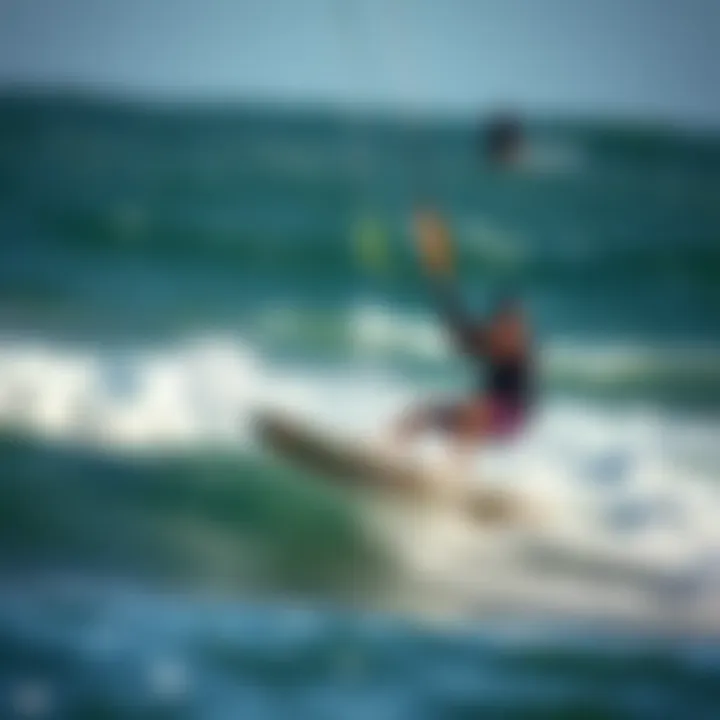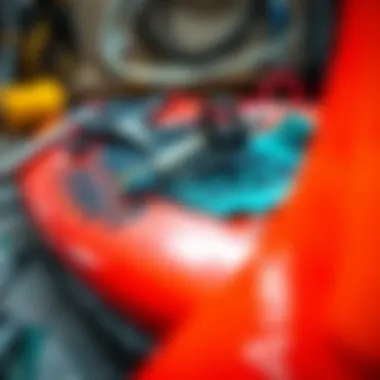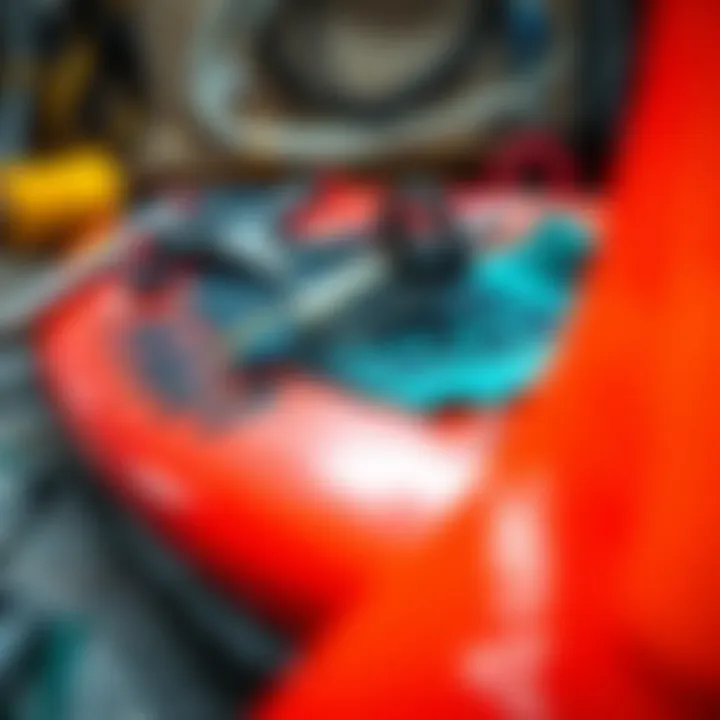Armstrong Surf Foils: A Deep Dive into Performance


Intro
Armstrong surf foils are carving a niche in the dynamic world of kiteboarding, providing riders a unique experience on the water. Whether you’re a novice eager to learn the ropes or a seasoned pro looking to refine your skills, understanding these innovative devices is crucial. The construction, design, and technology behind these foils elevate the adrenaline rush that comes with kiteboarding. In this exploration, we will delve into the specifics, from the essential gear needed to get started, to expert techniques to master the waves like a pro.
Gear and Equipment
An investment in the right gear can make all the difference in your kiteboarding experience. Here’s a look at the essentials you’ll need to hit the water, focusing primarily on Armstrong surf foils.
Essential Kiteboarding Gear for Beginners
Starting with kiteboarding can feel overwhelming, but a solid foundation in gear will set you on the right path.
- Kite - The heart of your kiteboarding setup; it propels you into the winds. For beginners, a trainer kite is recommended to hone your skills on the ground.
- Control Bar - This tool connects you to the kite and helps in steering. Look for one that fits comfortably in your hands.
- Harness - A comfortable and secure harness is essential for enjoying longer sessions without fatigue. Opt for a seat or waist harness based on preference.
- Board - While traditional boards are fine, a specific surf foil board from Armstrong can help beginners quickly transition from flat water to catching waves.
- Safety Gear - Enough cannot be said about the importance of a helmet and impact vest. Keeping yourself safe should always come first.
Advanced Equipment for Experienced Riders
Once you’ve mastered the basics, stepping up your gear is the next logical progression.
- Foil Setup - Armstrong's foils come in various designs, allowing for customization based on style and conditions. The difference in aspect ratios and front wing designs can affect speed and maneuverability.
- High-Performance Kite - Advanced riders may prefer kites designed for speed or stability in high winds, adding further excitement to their rides.
- Footstraps - As you progress, adjustability in footstraps can enhance your control when riding aggressive waves.
- Travel Bag - If you plan to explore different water spots, a high-quality travel bag specifically for your foil setup is great for protecting your gear.
"Choosing the right gear can either make or break your kiteboarding experience; invest wisely and enjoy every session."
Techniques and Tips
Having the right equipment is one thing, but employing the right techniques and practicing often is what truly elevates your kiteboarding experience. Here are some essential practices to keep in mind:
Safety Practices for Kiteboarding
Safety isn’t just a buzzword; it’s a way of life when you hit the waves. Here are some critical practices:
- Know Your Environment - Understanding tides, wind directions, and local rules is paramount.
- Pre-Flight Checks - Always inspect your gear before launching to minimize risks.
- Emergency Procedures - Familiarize yourself with quick release systems and how to self-rescue.
Training Techniques to Improve Your Skills
Refinement comes with practice and the right methods to enhance your skills:
- Video Analysis - Recording your sessions can provide insights that training on your own doesn’t reveal.
- Join a Community - Online forums such as Reddit or local groups can offer support and advice.
- Practice on Protected Water - Start in calmer areas to build confidence in your new skills before venturing into more challenging conditions.
End
By investing in the right gear, adhering to safety practices, and always honing your techniques, your experience with Armstrong surf foils can transform how you interact with the waves. This exploration of kiteboarding opens up a thrilling lifestyle, blending adrenaline with artistry. As you learn and grow, the ocean becomes your playground, where every session is an opportunity to elevate your skills and enjoyment.
Intro to Surf Foiling
Surf foiling is a thrilling convergence of surfing and hydrofoil technology, offering an exhilarating experience on the water. It transforms how surfers interact with waves, creating a sensation akin to flight as the foil lifts the board above the waves. This article takes a deep dive into surf foiling, particularly focusing on Armstrong surf foils, exploring their construction, advantages, and practical applications in various water sports. For kiteboarding enthusiasts and newcomers alike, understanding surf foiling is essential for enhancing their time on the water and mastering the art of riding waves with finesse.
Defining Surf Foils
Surf foils consist of a board, a mast, and a hydrofoil, which is the crucial component that provides lift. The hydrofoil itself resembles an airplane wing, generating lift as it moves through the water. This lift allows the surfer to ride above the water's surface rather than on it, which drastically changes the dynamics of surfing. This aspect is especially enticing for those seeking new thrills on the waves.
To clarify, surf foils operate based on the principles of hydrodynamics and lift. When the board accelerates, the hydrofoil cuts through the water, creating a pressure differential that lifts the board and rider above the surface. The result is a smooth, gliding experience that is both serene and exhilarating.
Many surf foils are designed with adaptability in mind, allowing for a range of riding styles and conditions, which can suit different riders from beginners to seasoned pros.
History of Surf Foiling
The origins of surf foiling trace back to the 1960s, emerging from the ingenuity of pioneers who sought to blend surfing with the advancements in windsurfing. The concept bubbled to the surface more prominently in the late 1990s, thanks to figures like Laird Hamilton and his crew who experimented with foils on various watercraft. Their vision led to the advent of modern surf foiling, enabling a new generation of athletes to push boundaries.
Since then, surf foiling has evolved significantly. The technology has improved, with more durable materials and refined designs allowing for enhanced performance and accessibility. As more riders flock to the water with these innovative tools, surf foiling has carved a niche within the broader water sports community, appealing to those craving adventure and new challenges.
Overview of Armstrong Surf Foils
Armstrong surf foils have carved a unique niche within the corazzi of water sports, drawing attention from kiteboarders, adventure seekers, and recreational athletes alike. Understanding the essence of Armstrong surf foils provides invaluable insight into not just their design, but also the philosophy that drives their creation and the innovations that push the boundaries of performance.
Key elements in exploring Armstrong surf foils include the brand's rich history, its commitment to user-centric design, and the innovative technology that fuels its product range. Each of these components aims to enhance your riding experience, whether you are new to the sport or a seasoned pro.
This section illuminates the significance of Armstrong surf foils and discusses the details that make them a compelling choice for those who crave the thrill of gliding over water. As we delve into the narrative of Armstrong, you will see how their products not only meet the demands of the waves but also resonate with the spirit of adventure inherent to water sports.
Brand History and Philosophy
Armstrong Foils began its journey rooted in a passion for the water and the desire to create cutting-edge equipment that empowers riders. The brand was established with a clear goal: to provide durable and performance-oriented surf foils that can withstand the rigors of various conditions while enhancing rider control. This mission has fostered a unwavering belief that technology and craftsmanship should go hand in hand. Armstrong insists on using aerospace-grade materials, which sets the tone for quality right off the bat. Their commitment to making both recreational and competitive riders successful reflects their understanding of the diverse needs in the surf community.
"Craftsmanship is at our core; every detail matters when it comes to creating a product that elevates the riding experience." – Unknown


Armstrong’s philosophy revolves around user experience and innovation. By prioritizing feedback from riders across various skill levels, they’ve nurtured a culture of continuous improvement. Their involvement in the surfing community allows them to delve deeper into what truly makes a quality foil. This connection drives their relentless pursuit of refinement.
Product Range and Innovations
Armstrong's product line showcases a fascinating array of surf foils, designed with precision and attention to detail. The range unfolds into several models suited for different surfing styles, from kite foiling to paddleboarding. Each model is crafted to address varying conditions, ensuring that riders can find the perfect match for their needs.
One of the stand-out features of Armstrong surf foils is their modularity. Riders can mix and match components, including wings, masts, and fuselages, allowing for tailored geard. This adaptability not only extends the life of the gear but also enhances performance as riders can customize their setups. Popular options like the Armstrong A+ series rear wings focus on stability and maneuverability, fostering a dynamic balance that many advanced riders admire.
Innovations on the Horizon
Armstrong is constantly pushing the envelope, researching advanced materials and aerodynamic shapes that promise to improve performance. The incorporation of 3D modeling and wind tunnel tests encapsulates their commitment to innovation. Riders can look forward to seeing features that optimize lift and minimize drag, making for an exhilarating experience on the water.
By combining cutting-edge technology with a rider-centric approach, Armstrong surf foils not only promote superior performance but also cultivate a deeper connection with the water. As these innovations come to fruition, the landscape of surf foiling is set to evolve, driven by the expertise and vision of Armstrong.
Engineering Behind Armstrong Surf Foils
The engineering of Armstrong surf foils is the backbone of what makes them stand out in a competitive market. It encompasses everything from the choice of materials to advanced design features that provide riders with a unique experience. Understanding the engineering aspect is vital, as it allows potential users to appreciate how specific elements contribute to performance, durability, and overall riding experience.
Materials Used in Construction
Armstrong is known for its meticulous selection of materials. They prioritize elements that not only provide strength but also minimize weight. The most common materials found in the construction of their surf foils include carbon fiber and aerospace-grade aluminum. Here's a closer look:
- Carbon Fiber: This material is celebrated for its high strength-to-weight ratio. When used for wings and masts, it allows for lightweight foils that maintain stiffness, which is crucial for performance and responsiveness on the water.
- Aerospace-Grade Aluminum: Offering durability without the excessive weight, aluminum is often used for components that require resilience, such as the fuselage.
- Benefits: The combination of these materials allows Armstrong foils to remain robust against the rigors of ocean conditions while ensuring that riders can navigate dynamically and efficiently.
In addition, Armstrong incorporates a top-notch epoxy resin system that protects the foils from UV damage and impacts, extending their lifespan in salty environments.
Design Features and Technology
The design features of Armstrong surf foils are nothing short of cutting-edge. Each foil is crafted with precision, focusing on aerodynamics to enhance performance.
- Wing Shapes: Armstrong utilizes various wing shapes tailored for different riding styles. For example, a wider wing can enhance lift, which is advantageous for riders looking to rise quickly above the water, while a narrower wing is ideal for speed and maneuverability.
- Tail Profile: The tail's design plays a significant role in maintaining stability during high speeds and sharp turns. Armstrong foils are equipped with technology that optimizes drag reduction and elevates lift.
- Fuselage Design: Their fuselage provides a streamlined connection between the wings and the mast, ensuring that the foil responds instantly to a rider's movements.
- Modular Systems: One of Armstrong’s standout features is its modular design, allowing riders to easily swap out parts to customize their setup according to conditions or preferences. This adaptability makes it appealing to both beginners and seasoned riders.
It's clear that Armstrong focuses not just on the aesthetics of design but also on functional engineering that enhances performance in real-world conditions.
In summary, the engineering behind Armstrong surf foils interweaves advanced materials and innovative design to cater to a broad spectrum of riders. By understanding these elements, enthusiasts can choose foils that not only suit their style but also enhance their overall surf foiling experience.
Performance Characteristics
When it comes to surf foiling, performance characteristics are not just fluff discussed on the beach after a long day; they truly shape the experience on the water. Key elements like lift, drag, stability, and maneuverability influence everything from the way a surfer glides above the water to how they respond to changing conditions. Understanding these characteristics can make a world of difference for kiteboarders, adventure seekers, and sports enthusiasts who revel in the thrill of flight over waves.
Successful foiling relies heavily on the balance of these factors. A foil's performance can either elevate your ride or leave you floundering like a fish out of water. Let's break it down further.
Lift and Drag Profiles
Lift and drag are more than just physics terms tossed around in a classroom setting. They are the twin pillars that dictate how effectively a foil can elevate a surfer above the water's surface. Lift refers to the upward force generated by the foil as it moves through water, while drag is the resistance encountered in that same motion.
- Lift:
- Drag:
- A well-designed foil can provide substantial lift with minimal effort, allowing riders to feel that exhilarating sensation of almost floating above the surface. This capability is particularly valuable for those who prefer smaller waves or slower water conditions.
- Factors such as the aspect ratio of the wing, the shape of the profiles, and the angle of attack come into play here. A higher aspect ratio generally leads to more lift and efficiency in gliding.
- On the flip side, an undesirable amount of drag can slow a rider down, often resulting in a frustrating and less thrilling experience. Riders want to avoid anything that resembles a barn door; sleek designs are the name of the game.
- Understanding how to position your body and adjust the foil's angle can help optimize performance by reducing drag, allowing for those longer, tube-like rides that surfers dream about.
In essence, mastering lift and drag profiles means being able to manipulate the foil's behavior in various conditions, giving riders confidence to tackle differing environments.
Stability and Maneuverability
Once lift has been achieved, keeping it stable becomes the next hurdle. Stability and maneuverability are also integral to the overall experience of surf foiling -- they determine not only whether a rider stands upright but also how easily they can navigate through waves.
- Stability:
- Maneuverability:
- Ensuring the foil remains stable throughout the ride translates to fewer wipeouts and more time spent riding the wind and water. A stable setup allows for riders to feel secure—an aspect that cannot be understated, especially for those just stepping into the sport.
- The shape of the foil’s mast and wings, combined with the rider’s weight distribution, are crucial to ensuring stability. A lower center of gravity, for example, can lead to a smoother ride.
- People often think moving quickly is the thrill, but it's actually about how adeptly one can change directions. Maneuverability ensures that riders can quickly alter their path to react to waves or other surfers. This characteristic makes for unexpected, exhilarating moments on the water.
- The tuning of dimensions such as wing size and aspect ratio can provide a balance between speed and agility that is tailored to individual preferences and skill levels.
In sum, understanding lift, drag, stability, and maneuverability not only helps in selecting the right Armstrong foil but also empowers riders to enhance their skills and confidence out on the waves. Each characteristic interlinks compactly, creating a symphony of performance that culminates in a rewarding surf foiling experience.
"To ride is to understand the delicate dance between lift and drag, stability and maneuverability; it's not just a sport, it's an art."
For more information on surf foiling techniques and performance, visit Wikipedia or check community insights on Reddit.
Engaging with these aspects equips not just seasoned adventurers but also newcomers, allowing them to hit the water with the right knowledge and gear for optimum performance.


Comparison with Other Foils
When considering the world of surf foiling, having a solid understanding of how Armstrong foils stack up against others on the market is crucial. This comparison is not merely a check on specifications but a nuanced conversation that dives into performance, usability, and rider experience. Knowing the specific elements—such as lift capability, durability, and ease of use—can significantly influence a rider’s enjoyment and effectiveness on the water.
Advantages of Armstrong Foils
Armstrong foils continuously attract attention from both seasoned riders and newcomers due to several standout features:
- Enhanced Lift Profiles: Many surf foilers swear by the increased lift that Armstrong foils provide, enabling better cruising speeds and smoother glides.
- Innovative Design: With a focus on aerodynamic shapes, Armstrong incorporates modern principles into their designs, allowing for exceptional performance in diverse conditions.
- Durable Materials: These foils utilize high-grade materials, making them resilient against wear and tear while still being lightweight, a balance not easily achievable by many competitors.
User testimonials highlight these advantages, with many riders commenting on how they can easily catch waves and maintain stability even in choppy waters. The intuitive handling of Armstrong foils contributes to a smooth ride that is often attributed to their craftsmanship. This edge gives riders the confidence to push their limits.
"Some foils feel clunky and hard to manage, but switching to my Armstrong changed everything. Now, I can focus on the waves, not just fighting my gear."
— A seasoned foiler's insight.
Limitations and Challenges
Nevertheless, while Armstrong foils boast numerous benefits, they are not without their hurdles:
- Price Point: Often seen as premium products, the cost can be a barrier for entry-level foam riders. For those just dabbling in the sport, this might deter them from making the transition.
- Learning Curve: While Armstrong foils have a reputation for great performance, they may have a steeper learning curve compared to simpler, more forgiving models. New riders might find that mastering their techniques takes more practice and patience.
- Specific Conditions: Not every foil performs at its peak across all conditions. While Armstrong foils excel in certain scenarios, they might not be the best choice for every rider or locale, particularly in light wind.
The understanding of these limitations is essential for potential buyers. They need to weigh these challenges against the advantages before making a commitment to invest their time and resources.
In summary, the comparison of Armstrong foils to other products in the market highlights both their remarkable strengths and noted limitations. Each rider’s needs are different, and an informed decision often leads to a better riding experience, making it well worth the discussion.
User Experiences and Feedback
User experiences and feedback play a vital role in understanding the real-world applications and effectiveness of Armstrong surf foils. They provide insights that go beyond the technical specifications and marketing jargon. Riders bring their perspectives, sharing how these products perform under various conditions, from the speed and agility they offer to the stability they provide on different types of water. Hearing directly from users helps paint a fuller picture and encourages a balanced view regarding the equipment’s advantages and limitations. This sort of information is invaluable for prospective buyers—those looking to invest time and money into surf foiling.
Testimonials from Experienced Riders
Many seasoned surfers have taken to sharing their stories with Armstrong foils, highlighting unique experiences and outcomes. For instance, riders like Alex, who has spent years on various water equipment, noted that the transition to using an Armstrong foil was 'like moving from a bicycle to a motorbike' in terms of ease and speed across water. The foils are praised for their impressive lift, allowing more time above the water and fostering a sense of freedom rarely found in traditional surfing.
Additionally, experienced riders have commented on the durability of Armstrong products. A long-time competitor, Jenna, emphasized during a review, “I’ve used my foil in harsh conditions, taken some nasty tumbles, but it survives it all. The construction is solid.”
Yet not every rider faces the same experience. Some emphasize that mastering the handling of Armstrong foils took time and patience. This highlights the importance of proper technique when using advanced equipment. Riders often share tips on how to balance, adjust stance, and how subtle shifts can lead to different outcomes. The community finds it beneficial to learn from each other, making testimonials not just personal tales but instructional insights.
Insights from Beginners
For beginners, entering the world of surf foiling can be both thrilling and daunting. Newcomers often document their first impressions through platforms like Reddit and dedicated surf forums. Many initial reactions to using Armstrong foils are filled with excitement but also a fair share of surprises. Sarah, a rookie who took her first surf foil ride recently, shared, “I didn’t expect the initial lift to be so exhilarating and terrifying at the same time!”
Most beginners benefit from frequent advice regarding gear setup and safety measures. Being new to the sport, they often ask questions about what to consider before hitting the water. Recommendations from experienced riders are immensely helpful. Many suggest starting with a larger foil to improve balance before transitioning to more advanced equipment. The general consensus is that Armstrong foils can offer a soft landing when learning because they respond to rider inputs more gracefully than some other brands. Beginners appreciate getting guidance on how to navigate their learning curves effectively while using Armstrong gear.
In summary, user experiences and feedback form a bridge between technical specifications and practical applications. They not only validate the performance claims but also foster a supportive community among kiteboarders and surf enthusiasts. Whether you're a seasoned veteran or just dipping your toes in surf foiling, understanding these experiences can enhance your own journey on the water.
Optimal Conditions for Surf Foiling
When it comes to surf foiling, the right conditions can make all the difference between a thrilling experience and a frustrating one. Understanding how wind and water interact is crucial for riders looking to maximize their skill set. Without favorable conditions, even the best gear can seem inadequate, leading to less satisfactory results and potential safety hazards. Here, we will explore the interplay of various elements that create optimal surfing conditions, allowing kiteboarders and enthusiasts to get the most out of their Armstrong surf foils.
Wind and Water Conditions
Wind and water conditions are the backbone of an exhilarating surf foiling experience. A good understanding of these elements not only elevates performance but also enhances safety.
- Wind Speed: Optimal wind speeds typically range between 10 to 25 knots. Too little wind can leave riders grounded, while excessive gusts can become dangerous and reduce control. Riders must have a feel for their gear and adjust accordingly to the wind strength.
- Wind Direction: Onshore or offshore wind can significantly impact the ride. Onshore winds tend to create chop, which can be challenging for beginners. Conversely, offshore winds provide a cleaner and smoother experience, allowing for better lift and glide.
- Water Conditions: Look for waters with minimal chop and consistent waves. Flat water is generally best for beginners to practice their skills without getting tossed around. As riders become more experienced, choppy or wavy conditions can add a new layer of excitement.
- Tidal Influence: Tides can drastically alter the surfing conditions. Riding during high tide in coastal areas often yields better wave conditions. However, it’s important to be aware of tidal currents, especially in specific locales known for strong runs.
"The right winds and water make a rider's heart sing, while the wrong conditions can lead to painful experiences."
Best Locations for Surf Foiling
Choosing the right location is almost as important as the conditions of wind and water. Here are several renowned spots that both novice and experienced riders find alluring:
- Hawaii: Legendary for its surf, locations like Maui and Oahu offer consistent winds and waves, making them ideal for foiling.
- California: Places like San Francisco and the Channel Islands tend to have excellent surf foiling conditions, with various spots catering to different skill levels.
- Florida: The clear waters and varied winds provide a fantastic playpen for different foiling styles, with locations like the Florida Keys being particularly favorable.
- Australia: With diverse coastal landscapes, spots like Gold Coast are favorable due to their consistent wind patterns and friendly surf culture.
For those venturing out to foil, it’s wise to connect with local communities via online forums, such as rediit.com, to gather current information about conditions and to find hidden gems in surf foiling hot spots.
Safety Considerations
When it comes to surf foiling, safety can't be an afterthought. It’s crucial to respect the inherent risks associated with this exhilarating activity. Surf foiling often takes place in dynamic and unpredictable environments, where wind, water currents, and wave conditions can change on a dime. Understanding essential safety considerations not only protects you but can greatly enhance your overall experience on the water, allowing you to focus on mastering your skills rather than worrying about potential hazards.
Safety protocols serve as the bedrock upon which enjoyable and thrilling surfing experiences are built. By having basic safety measures in place, both seasoned pros and beginners will find themselves better equipped to handle unexpected situations, thereby maximizing their time spent foiling.
"Safety is not just about the gear you wear; it’s about the mindset you bring to the water."
Foiling Safety Guidelines


Before hitting the water, having a clear grasp of safety guidelines is paramount. Here are some important points to consider:
- Check Weather Conditions: Always start with a quick assessment of weather patterns. Look out for sudden changes; strong winds and stormy conditions can be dangerous for beginners.
- Know Your Limits: It’s tempting to push your limits, especially when the surf is just right. However, knowing when to call it a day is equally as critical as pushing your skills.
- Stay Aware of Your Surroundings: Pay attention to other surfers and swimmers. Collisions can happen quickly, and being aware can prevent potential accidents.
- Wear a Personal Flotation Device: Always wear a PFD. This is non-negotiable. If you find yourself in trouble, having that extra buoyancy can make a substantial difference.
- Practice Proper Teardown Procedures: After a session, don’t rush. Properly stowing and securing your foil can avoid accidents and damage.
Gear Recommendations for Safety
Selecting the right gear not only adds to your performance but assures your safety. Here are some gear recommendations:
- Wetsuit: A good wetsuit not only keeps you warm but also provides an additional layer of protection against cuts and scrapes.
- Impact Vest: Opt for an impact vest, especially when learning new tricks. They absorb impacts and offer extra buoyancy.
- Leash: Invest in a reliable and strong leash to keep your board connected to you.
- Helmet: Wearing a helmet is a simple yet effective way to protect your head from unintentional bumps.
- Safety Whistle: Having a whistle attached to your gear can be an invaluable tool for signaling if you find yourself in distress.
Maintenance and Care for Armstrong Foils
When it comes to keeping your Armstrong surf foils in top shape, maintenance and care elevate your riding experience significantly. Regular upkeep not only extends the life of your gear but also ensures optimal performance on the water. Surf foiling isn’t just about catching waves; it's about being equipped with reliable tools that respond well to your movements. Proper maintenance is an investment in your overall surfing adventure.
Cleaning and Storage Tips
Cleaning your surf foils after each session is crucial. Saltwater, sand, and debris can lead to corrosion and wear over time. Here are some practical tips for keeping your gear pristine:
- Rinse with fresh water: Right after you come out of the water, give your foil a thorough rinse. Use a hose or dunk it in a bucket of fresh water to remove salt and sand.
- Use a soft cloth: After rinsing, use a soft, non-abrasive cloth to wipe down the components. Pay attention to the joints and any intricate parts where salt can accumulate.
- Dry completely: Don’t just put it away damp. Allow your foils to dry completely before storing them to prevent rust and mildew. A dry cloth can help remove remaining moisture.
- Store in a cool, dry place: When not in use, your foils should be stored in a place away from direct sunlight and extreme temperatures. A dedicated storage bag can protect them from scratches and environmental factors. Ideally, keep them in a location that’s well-ventilated.
These simple steps can save you from unnecessary repairs and ensure your foils last longer.
Common Repairs and Troubleshooting
Despite your best efforts, wear and tear is sometimes unavoidable. Knowing how to tackle common issues can keep your surf foils in excellent condition. Here are a few repairs you might encounter:
- Dings or cracks in the foil: If you find a noticeable ding or crack, use epoxy resin to seal it. Clean the damaged area first, then apply the resin according to the instructions on the package. It’s crucial to let it cure fully before your next ride.
- Loose screws or fittings: Regularly check that all screws and fittings are tight. A loose screw can lead to bigger problems down the road. If you find any that won’t tighten, consider replacing them or consulting a professional for advice.
- Algae or mildew buildup: If you notice any green buildup on your foil, it’s likely algae. A mixture of white vinegar and water can help remove it. Just be sure to rinse thoroughly afterward to avoid corrosion.
"Regular maintenance is just as essential as the ride itself. Taking care of your gear makes each session more enjoyable."
By following these guidelines on maintenance and care, you not only enhance your foiling experience but also reduce the risk of unexpected issues while you’re out on the water. Being proactive about your surf foils is key to enjoying the sport to its fullest.
Future Trends in Surf Foiling
With the rapid evolution of water sports, it's vital to keep our eyes on the future, especially in the realm of surf foiling. The advancements in this niche sport not only reflect technological progress but also stimulate creativity among surfers and manufacturers alike. As kiteboarders and adventure seekers, understanding these trends enables us to harness emerging technologies that enhance our experience on the water.
The significance of future trends in surf foiling cannot be overstated. They shape how equipment is designed, how riders can adapt to various conditions, and how the sports community evolves. Keeping an eye on these trends means staying ahead of the curve and optimizing performance, safety, and enjoyment.
Innovations on the Horizon
The surf foiling landscape is poised for exciting developments, particularly in materials and design technology.
Some noteworthy advancements include:
- Eco-friendly Materials: There's a growing emphasis on sustainability in manufacturing. Companies are exploring biodegradable foils and recyclable components to align with environmental needs.
- Smart Technology Integration: Some brands are now tinkering with the idea of smart foils that gather data on water conditions and rider performance. Imagine having a foil that helps you adjust your riding style based on real-time analytics!
- Enhanced Aerodynamics: Innovations continue to push the boundaries of aerodynamics. Hydrodynamic designs are becoming more sophisticated, allowing for less drag and more lift, hence enhancing performance.
- Customization Options: Personalization is also gaining traction. More manufacturers are offering customizable elements, such as adjustable wings and modular setups, catering to individual rider preferences.
"Innovation in surfing is not merely about speed or aesthetics; it cultivates a deeper connection with the ocean and empowers riders with tools that enhance their experience."
Evolving Techniques and Styles
As technology transforms the gear we use, riding techniques are also adapting. A deeper dive into evolving styles reveals a shift in approaches to surf foiling that are worth paying attention to.
Shifts in Riding Techniques include:
- Freestyle Foiling: This style is gaining traction among riders as they incorporate tricks and jumps into their routines. It’s an exhilarating way to express creativity and challenge traditional norms in surfing.
- Foil Surfing in Varied Conditions: Today, riders are pushing the limits by applying surf foils in a broader range of conditions—from small wave riding to tackling bigger swells. Mastering these increasingly diverse styles proves proficiency and adaptability.
- Collaboration with Other Sports: Interdisciplinary approaches are on the rise. Foiling skills are being borrowed from kiteboarding and windsurfing, creating unique hybrid techniques that diversify the sport further.
The synergy between technology and technique fosters a dynamic environment for growth. As everyone from beginners to seasoned professionals stay attuned to these evolving trends, the possibilities for surf foiling seem almost limitless.
Consider exploring forums like Reddit or fresh updates on platforms like Facebook to keep your finger on the pulse of this exciting journey.
Culmination
When diving into the world of surf foiling, wrapping your head around the vast potentials of Armstrong surf foils is crucial. This conclusion serves not merely as a summary but as a lens focusing on the tangible and intangible benefits tied to the innovative designs of Armstrong. From the construction materials to the nuanced technology woven into each foil, every aspect contributes to improving the overall experience for kiteboarders and adventure seekers alike.
Summarizing Key Insights
The highlights of this exploration underscore the significance of selecting the right gear for an enhanced water sports experience. Here are some key takeaways:
- Innovative Engineering: Armstrong surf foils leverage advanced materials and designs that prioritize not just performance, but also durability. Riders have reported feeling more confident and stable, allowing for smoother rides in varying conditions.
- Targeted Performance: Each product line is crafted with the goal of addressing specific rider preferences and conditions. Whether you are a seasoned professional or just dipping your toes into the world of surf foiling, there's an Armstrong foil that fits your needs.
- Safety First: With safety guidelines that highlight the necessary precautions, Armstrong ensures that while pushing the limits of performance, rider safety is never overlooked.
"Choosing the right surf foil significantly changes how one interacts with the waves and wind."
- Experienced Rider Feedback
Encouraging Further Exploration
In the broad sea of water sports, there's always more to learn and experience. Potential kiteboarders and curious adventurers are encouraged to consider further engagement with surf foiling, as it opens a treasure trove of skills and thrill. Here are a few suggestions for exploring this exhilarating sport:
- Join Community Forums: Websites like Reddit or Facebook groups dedicated to surf foiling are treasure troves of information. Connecting with fellow enthusiasts can provide insights into best practices and personal experiences.
- Hands-on Experience: There’s no substitute for first-hand experience. Look for local shops or schools that offer lessons on surf foiling. Nothing beats the exhilaration of learning by doing.
- Stay Updated on Tech Innovations: The world of surf foiling is ever-evolving. Following brands or trusted sites like wikipedia.org or britannica.com can help you stay in the loop regarding new technologies and gear.
Engaging further in the realm of surf foiling is not just about riding the waves; it's about being part of a community that’s constantly pushing the envelope of what's possible on water.



